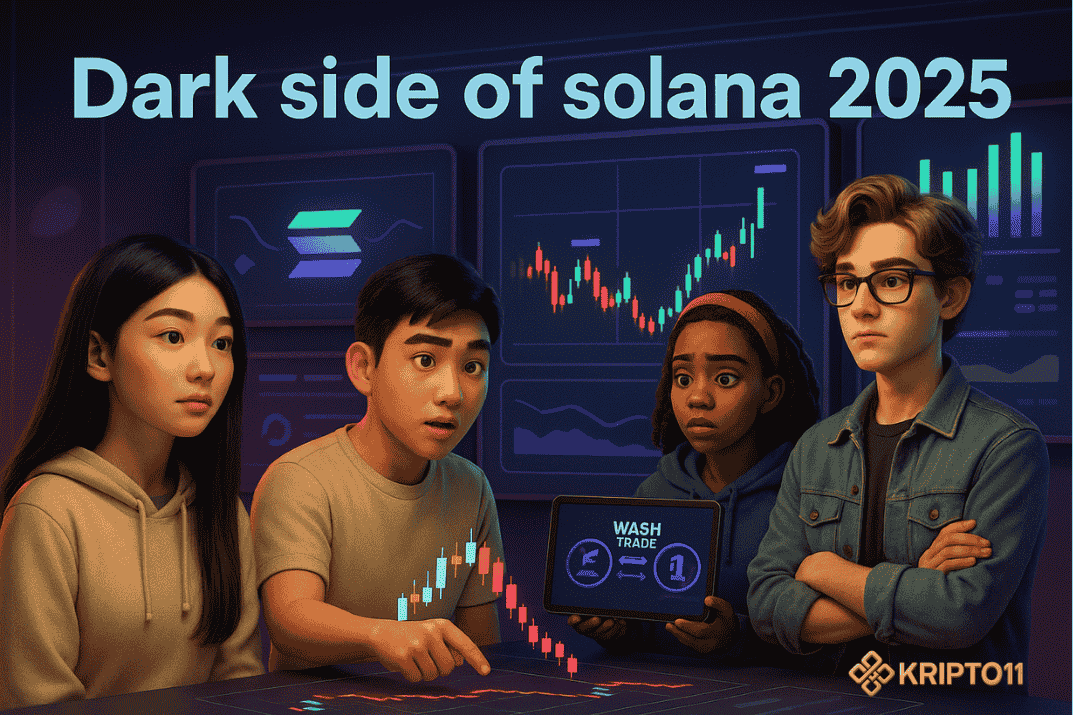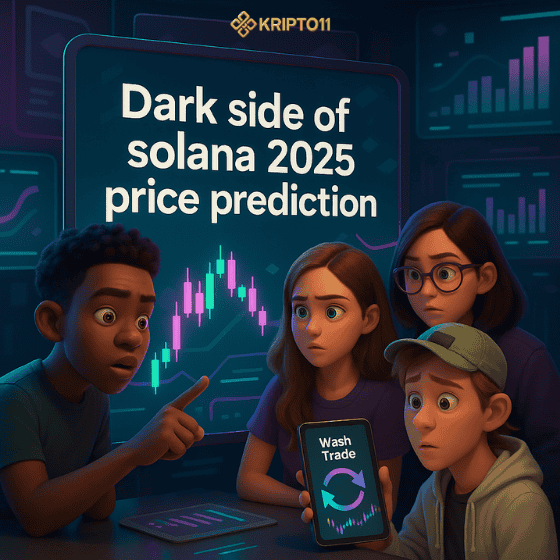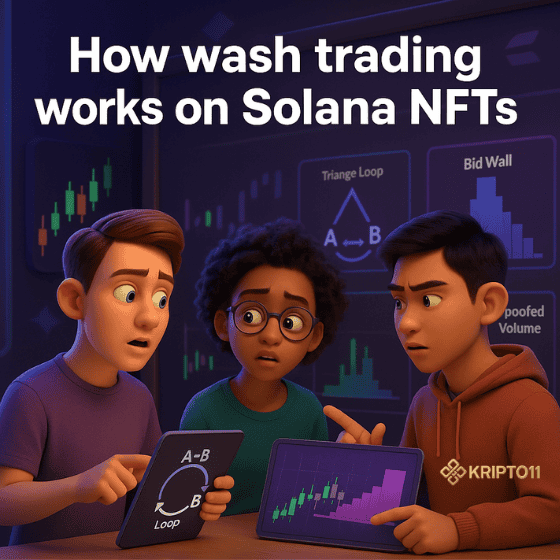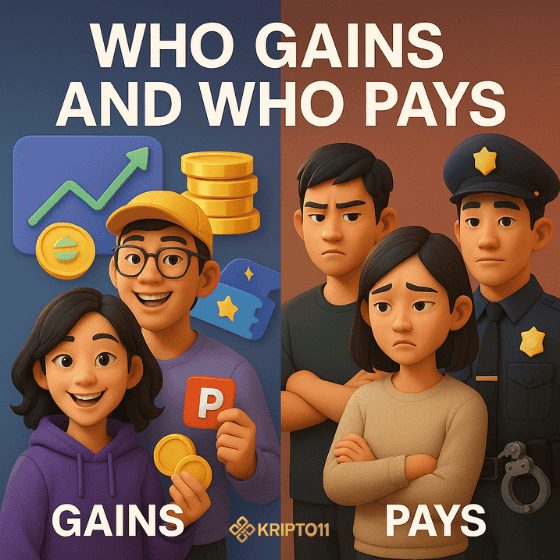Solana’s speed and tiny fees helped NFTs explode, yet those same strengths invite games that warp reality. In 2025, wash trades and spoofed volume blur the line between traction and theater, inflating floors, juicing dashboards, and baiting newcomers into costly moves. This isn’t abstract market noise; it shapes headlines, influences treasury decisions, and feeds bullish models that later break. The Dark side of solana 2025 emerges when bots recycle assets across linked wallets, while bid-walls appear and vanish to manufacture urgency.
This guide maps the patterns, explains why they persist, and offers field-tested checks you can run before you buy, list, or launch. Read on to protect capital, support legitimate builders, and keep your data and narrative clean. And resilient.
Dark side of solana 2025 price prediction
Investors love neat models. However, when volumes look large because of wash trading and spoofed activity, models break.
Because the Dark side of solana 2025 price prediction narrative often leans on headline metrics-daily NFT volume, unique traders, floor moves-tainted data creeps in and nudges targets higher or lower than reality.
Consequently, forecasts for SOL, marketplace tokens, and top collections drift off course.
In practice, the Dark side of solana 2025 plays out like this: bots recycle the same assets between wallets to print “volume,” while sybil clusters ping bids around floors to simulate demand. Therefore, analysts who extrapolate from dashboards without cleaning the feed overestimate growth and misread risk. Moreover, media cycles amplify the illusion; viral threads repeat numbers without proper caveats. As a result, liquidity providers tighten quotes, genuine collectors hesitate, and teams pay more to acquire real users.
Key takeaways for price modeling
- Always label suspect trades before you run a Dark side of solana 2025 price prediction.
- Blend chain data with marketplace-level flags, and down-weight bursts that look circular.
- Stress-test your thesis against “noisy” and “cleaned” datasets to see how far your target shifts.
How wash trading works on Solana NFTs
Wash trading fabricates economic activity. On Solana, cheap fees and fast finality make rapid loops trivial. Therefore, a small cluster can swing a collection’s “24h volume” in minutes.
Circular sales and triangle loops
Two-wallet loops remain the simplest path: Wallet A “sells” to Wallet B, then Wallet B “sells” back, repeating at slightly higher prices. Meanwhile, a triangle loop (A→B→C→A) obscures symmetry and hides patterns from naive filters.
Air-dropping and bait floors
Wash traders often airdrop low-value tokens or whitelist perks to related wallets. Then they post a thin wall of slightly above-floor listings to bait momentum buyers. Because the wall looks organic, newcomers chase it and become exit liquidity.
Incentive farming disguised as organic volume
When marketplaces reward activity-rebates, points, or future “loyalty drops” washers game the rules. They randomize intervals, vary prices, and rotate metadata traits to bypass simple detectors. Consequently, “engagement” dashboards glow even when real demand remains flat.
Red flags
- Repetitive round-trips across a tiny wallet set
- Price spikes without matching social or holder growth
- Bursts of bids that cancel within seconds after fills
Spoofed volume tactics: bots, backfill, and bid-walls
Spoofing creates the illusion of depth and urgency. On NFT order books, that means fake bids, staged listings, and replayed fills.
Bot farms and choreographed bursts
Operators script synchronized buy/sell events during news windows or right after an airdrop snapshot. Therefore, observers perceive “breakout energy,” while bots simply ping-pong assets. Additionally, they can backfill historical data by pushing low-fee self-trades at off-peak hours to inflate “all-time” metrics.
Bid-walls and instant vanish
A thick bid-wall appears under the floor to suggest strong demand. Newcomers list into the wall; yet the wall vanishes at the last second, leaving thin real demand. Consequently, floors gap down and panic spreads.
Cross-marketplace mirroring
Spoofers mirror activity across multiple aggregators to multiply impressions. Because feeds scrape each other, one staged trade looks like a wave. Thus, influencers cite “multi-venue confirmation” that never existed.
How this warps the Dark side of solana 2025 conversation
- Trend models treat spoofed bursts as momentum, so they flag false “uptrends.”
- Influencer dashboards screenshot the spikes; narratives harden.
- Real treasuries deploy capital late and Solana pay the liquidity tax.
Who gains and who pays: incentives, victims, and enforcement
Winners (short-term)
- Points farmers who harvest rebates or eligibility for future distributions
- Promoters who showcase “traction” to raise rounds or sell paid mints
- Market makers who trade against confused retail during volatile windows
Losers (medium-to-long term)
- Retail buyers who anchor to manipulated floors
- Legit creators whose organic metrics look weak next to faked competitors
- Marketplaces that inherit reputational risk and potential regulatory heat
Enforcement pressure
Although crypto stays global, incentives change. As consumer-protection standards tighten, venues that tolerate wash activity invite delistings, fines, or de-banking. Therefore, even if on-chain actions remain permissionless, off-chain chokepoints-fiat ramps, ad networks, app distribution-become gatekeepers. Consequently, projects that rely on spoofed numbers risk sudden access loss.
Defensive playbook for buyers, founders, and marketplaces
For buyers and traders
- Correlate floors with holder growth. If unique holders stagnate while volume jumps, step back.
- Check trade counterparties. Repeated A↔B loops or triangle patterns? Avoid.
- Watch bid persistence. If bids vanish on touch, treat the wall as a mirage.
- Use conservative slippage and staged entries. Do not chase spikes.
- Track off-chain signals. Real demand produces comments, threads, and secondary team activity.
For founders and creators
- De-incentivize artificial churn. Cap per-wallet rewards, add anti-sybil scoring, and require time-weighted activity.
- Publish integrity dashboards. Show real DAU/MAU, retention, and net new wallets alongside sales.
- Adopt transparent royalty logic. Clear, enforceable rules reduce incentive to fake turnover.
- Run audit bounties. Invite the community to flag suspicious trades and pay for proofs.
For marketplaces and tooling teams
- Real-time anomaly detection. Combine time-series outlier models with graph clustering to flag loops.
- Quality-of-volume scores. Weight trades by counterparty diversity, holder tenure, and bid persistence.
- Points with friction. Reward diversity and duration, not raw trade count.
- Disclosure labels. Tag collections with “elevated manipulation risk” when thresholds trigger.
- Appeal paths. Let legit projects challenge flags with signed evidence.
Checklists you can copy today
- Data hygiene: remove self-swaps; collapse family wallets; down-weight <3-hop clusters.
- Narrative control: when you publish metrics, include a “cleaned vs raw” chart.
- Risk policy: define what triggers trading halts or listing reviews before drama hits.
FAQ: Dark side of solana 2025- wash trading & spoofed volume
Q1) Why does the Dark side of solana 2025 matter for everyday collectors?
Because manipulated metrics distort floors, you overpay, panic-sell at the wrong time, and lose trust in real builders.
Q2) How can I spot wash trading quickly?
Look for repetitive A↔B swaps, triangle loops, sudden volume without new holders, and bid-walls that vanish on touch. Additionally, compare across venues and timeframes.
Q3) Do spoofed volumes affect SOL itself?
Indirectly, yes. When NFT euphoria rides on fake demand, treasury flows and retail sentiment swing. Therefore, models that rely on NFT activity may misprice SOL risk.
Q4) What should founders do to avoid toxic incentives?
Tie rewards to time-weighted holding, unique participants, and verified engagement. Moreover, cap per-wallet payouts and publish integrity reports.
Q5) Is “clean” growth still possible in 2025?
Absolutely. Teams that design friction into incentives, court real communities, and disclose quality-of-volume metrics build durable demand-even when hype cycles fade.






